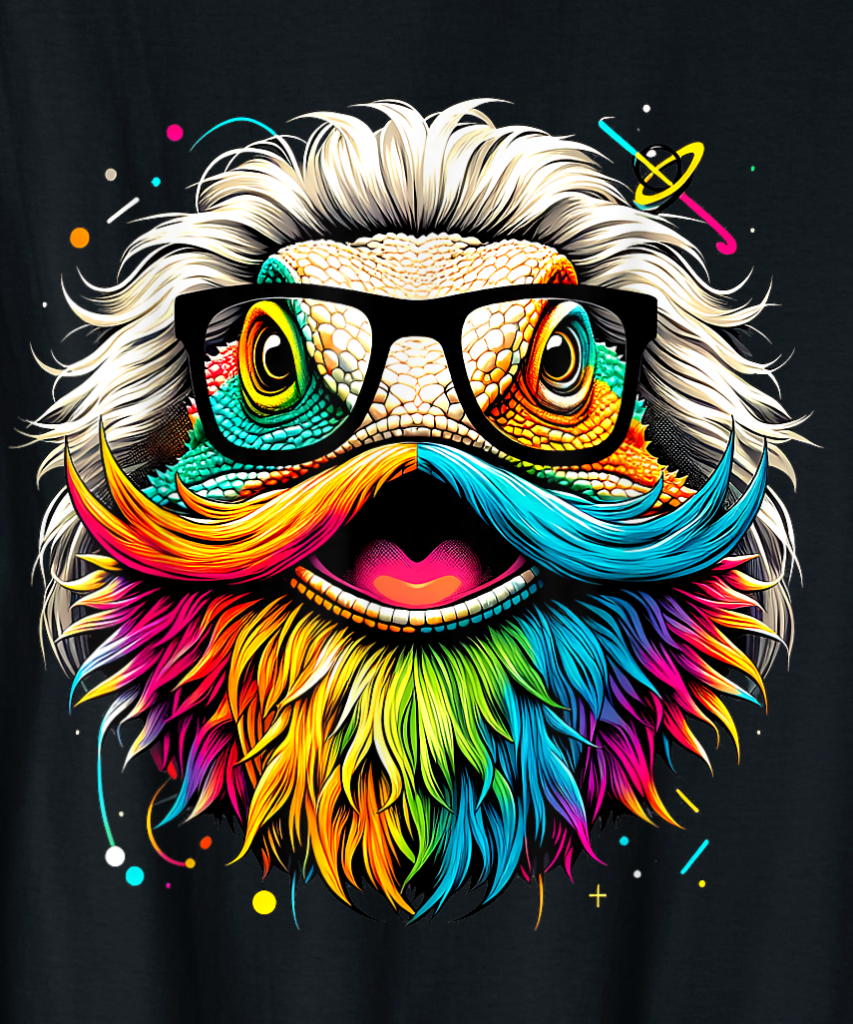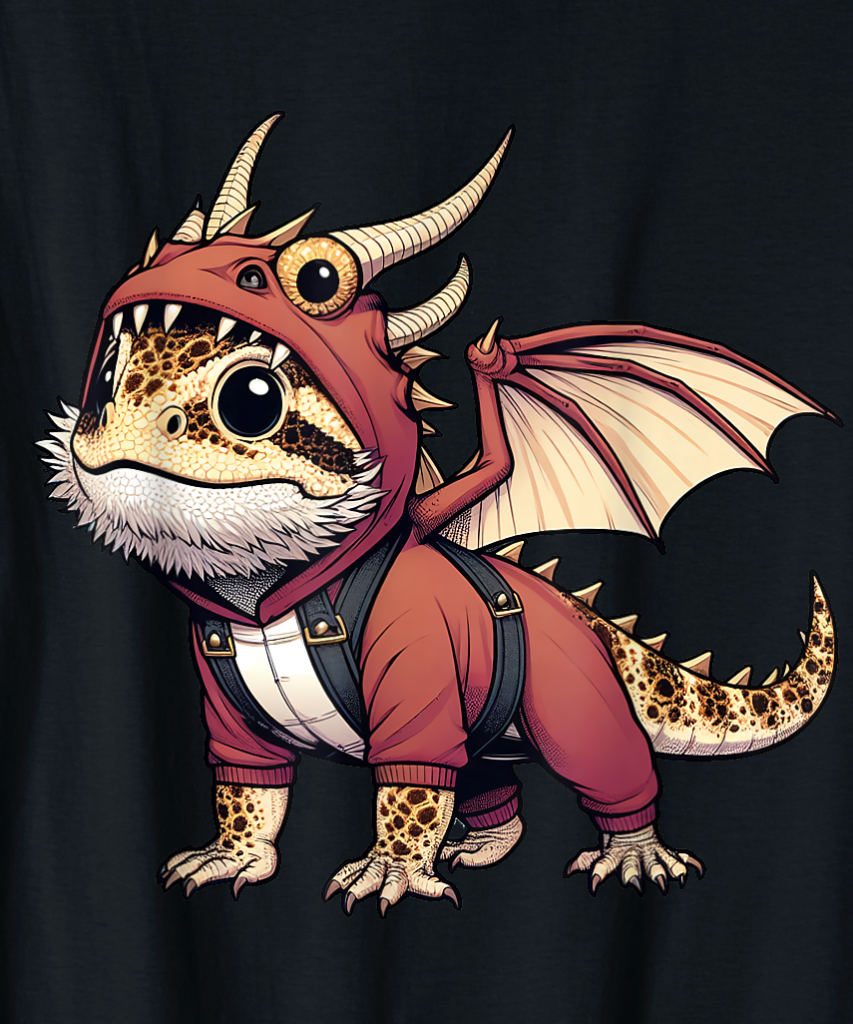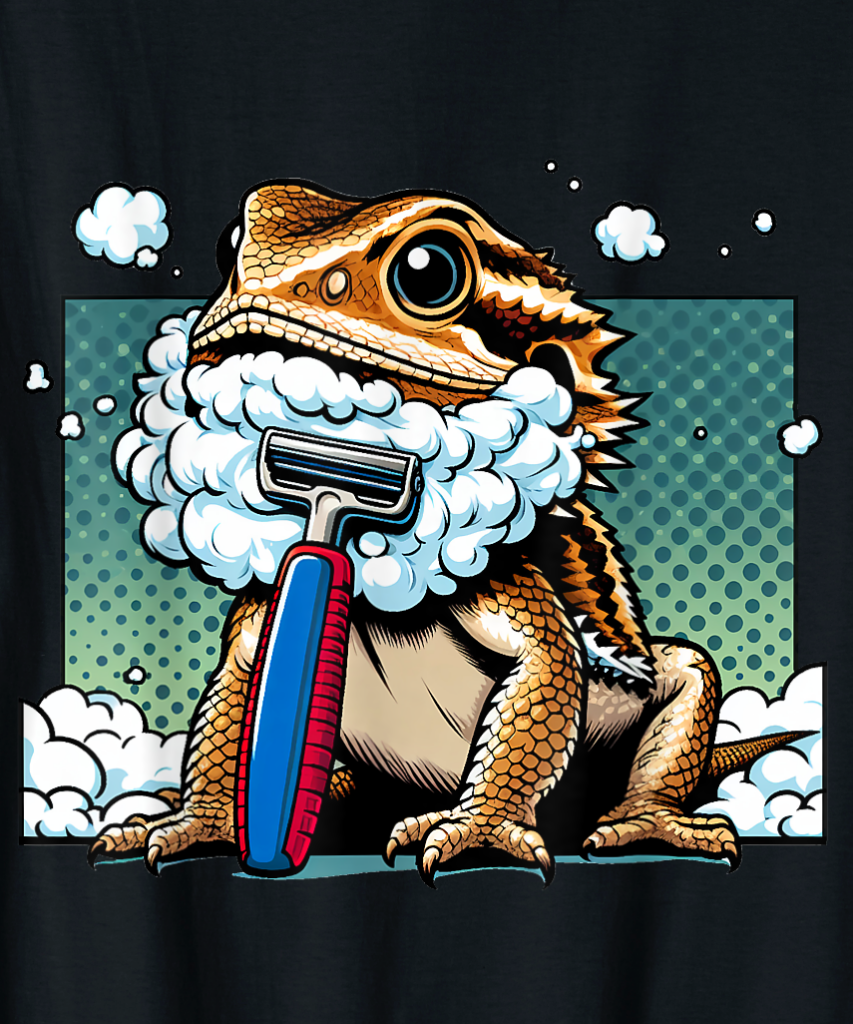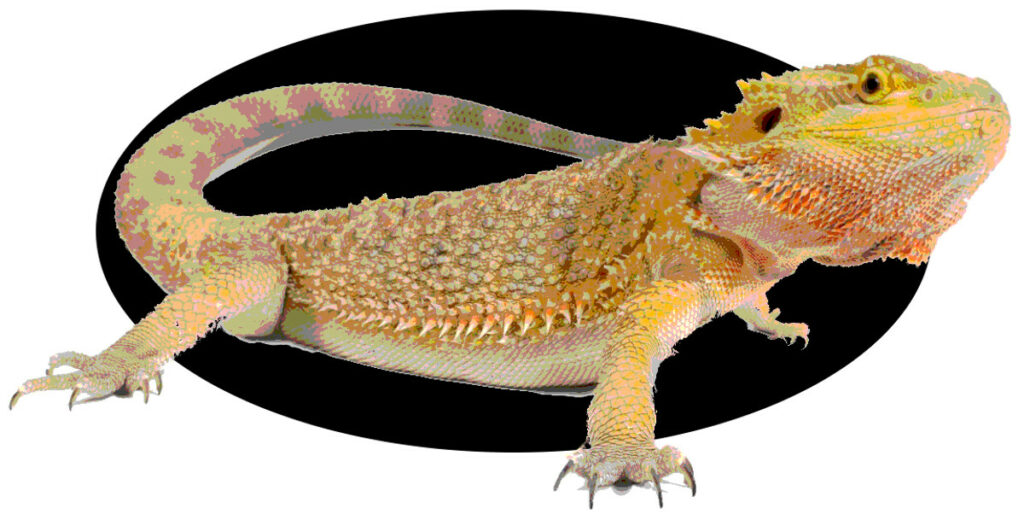Брадатите дракони са едни от най-популярните влечуги за домашни любимци, но те също имат специфични нужди и изисквания, които трябва да бъдат изпълнени, за да гарантират тяхното здраве и щастие.
This is especially true for baby bearded dragons, also known as hatchlings or juveniles, които са по-деликатни и уязвими от възрастните.
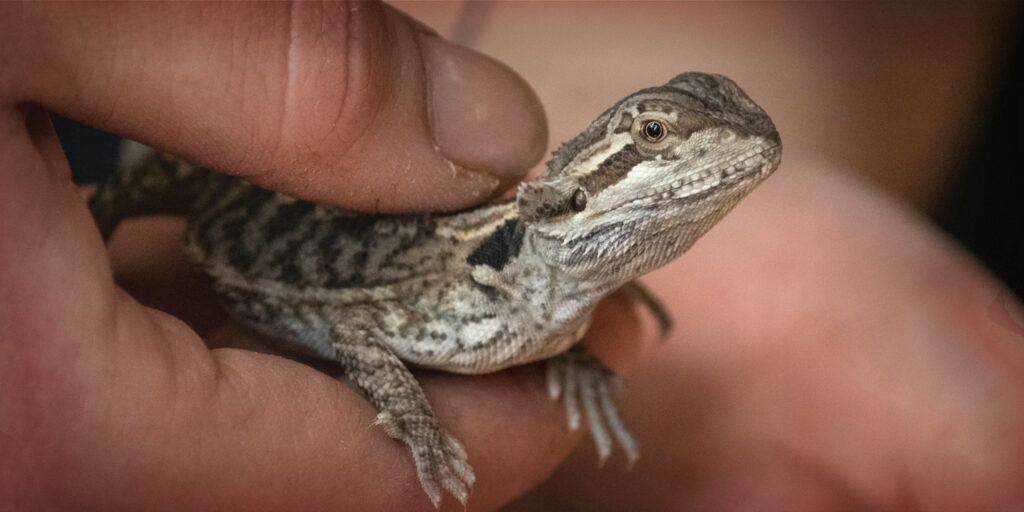
Baby Bearded Dragon Size Chart
A baby bearded dragon is very small when it hatches, measuring only about 3 inches long and weighing about 2 да се 3 грамове.
Baby bearded dragons grow very fast in their first year of life, reaching up to 16 да се 24 inches in length and over 350 grams in weight by the time they are 12 на месеци.
After that, they will not grow much longer, but they will continue to gain weight and fill out their body
Here is a table that shows the average size of bearded dragons by age:
| Възраст | Length | Тегло |
|---|---|---|
| люпило | 3-4 инча | 2-3 грамове |
| 1 month | 5-9 инча | 10-20 грамове |
| 2 месеца | 8-11 инча | 25-40 грамове |
| 3 месеца | 9-12 инча | 35-50 грамове |
| 4 месеца | 11-16 инча | 50-70 грамове |
| 5 месеца | 12-18 инча | 60-100 грамове |
| 6 месеца | 13-20 инча | 80-150 грамове |
| 7 месеца | 14-22 инча | 100-200 грамове |
| 8 месеца | 15-23 инча | 120-250 грамове |
| 9 месеца | 16-24 инча | 150-300 грамове |
| 10 месеца | 17-24 инча | 180-350 грамове |
| 11 месеца | 18-24 инча | 200-400 грамове |
| 12 месеца | 19-24 инча | 250-450 грамове |
Note that these are only average values, and your baby bearded dragon may be smaller or larger depending on its genetics, диета, and environment.
As long as your baby bearded dragon is eating well, shedding regularly, and showing no signs of illness or stress, you should not worry too much about its size.
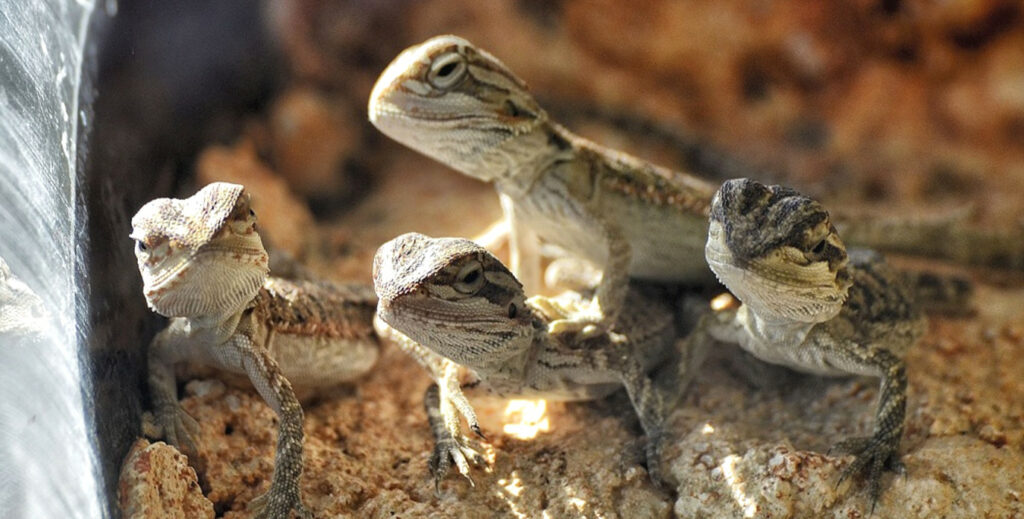
Baby Bearded Dragon Enclosure Requirements
The enclosure is where your baby bearded dragon will spend most of its time, so it is important to provide it with a suitable and comfortable habitat.
Here are some of the main factors you need to consider when setting up your baby bearded dragon’s enclosure:
Субстрат
The substrate is the material that covers the bottom of the enclosure. It should be safe, чиста, and easy to maintain. Some of the best substrates for baby bearded dragons are:
- Paper towels: These are cheap, абсорбент, and easy to replace. They also prevent the risk of impaction, which is when your baby bearded dragon accidentally ingests the substrate and causes a blockage in its digestive system.
- Tile: This is a hard and smooth surface that is easy to clean and disinfect. It also retains heat well and provides a good basking spot for your baby bearded dragon. въпреки това, it can be expensive and heavy, and you need to make sure it does not have any sharp edges or corners that could injure your baby bearded dragon.
You should avoid using substrates that are loose, dusty, or edible, като пясък, gravel, wood chips, bark, or alfalfa.
These can cause impaction, respiratory problems, or bacterial infections in your baby bearded dragon. They can also harbor parasites, mold, or fungus that could harm your baby bearded dragon.
Осветление
Lighting is essential for your baby bearded dragon’s health and well-being.
The lighting setup in your pet’s enclosure provides them with the necessary UVB rays that help them synthesize vitamin D3, which is needed for calcium absorption and bone health.
Light also regulates their circadian rhythm, which is their natural day and night cycle, and has important implication when it comes to growth, sleep, and overall health of your pet.
You need to provide your baby bearded dragon with a UVB light that covers at least 75% of the enclosure. The UVB light should be a linear fluorescent tube or a compact fluorescent bulb that emits 10-12% UVB.
You should avoid using incandescent bulbs, mercury vapor bulbs, or LED lights, as these do not provide enough UVB or may emit harmful UVC rays.
You should also replace your UVB light every 6-12 месеца, as the UVB output decreases over time. The UVB light should be placed inside the enclosure, about 10-12 inches above the basking spot.
You should not use any glass, plastic, or mesh between the UVB light and your baby bearded dragon, as these can filter out the UVB rays. You should also provide your baby bearded dragon with a regular white light that mimics the natural sunlight.
This can be a fluorescent tube, a compact fluorescent bulb, or a halogen bulb. You should not use any colored lights, such as red, blue, or purple, as these can distort your baby bearded dragon’s vision and behavior.
You should also avoid placing heat lamps too close to the ground, as these can overheat your baby bearded dragon.
The white light should be placed on the opposite side of the UVB light, to create a gradient of light and shade in the enclosure.
You should turn on both the UVB light and the white light for 12-14 hours a day, and turn them off for 10-12 hours at night. You should use a timer to ensure a consistent light cycle for your baby bearded dragon.
Heating
Heating is another important factor for your baby bearded dragon’s health and well-being. It provides them with the necessary warmth that helps them digest their food, regulate their metabolism, and fight off infections.
It also creates a temperature gradient in the enclosure, which allows your baby bearded dragon to thermoregulate, which is the ability to adjust their body temperature by moving between warmer and cooler areas.
You need to provide your baby bearded dragon with a basking spot that reaches 100-110°F, a warm side that ranges from 85-95°F, and a cool side that drops to 75-85°F.
You should use heat lamps hanging from above to create a basking spot. Be careful if you choose to use use a ceramic heat emitter, a radiant heat panel, or a heat mat as these can overheat or scorch your baby bearded dragon. You should also avoid using any hot rocks, as these can burn your baby bearded dragon.
You should place the heat source on the same side as the UVB light, about 6-8 inches above the basking spot. You should use a thermometer to measure the temperature at the basking spot, the warm side, and the cool side. You should also use a thermostat to regulate the heat output and prevent overheating or underheating. You should keep the heat source on for 24 hours a day, as baby bearded dragons need constant warmth to grow and develop.
въпреки това, you should also provide your baby bearded dragon with a night drop of 10-15°F, to mimic the natural temperature fluctuations in their native habitat. You can use a ceramic heat emitter, a radiant heat panel, or a heat mat to maintain the night temperature.
Влажност
Humidity is the amount of moisture in the air. It affects your baby bearded dragon’s hydration, skin health, and respiratory health.
You need to aim at maintaining a humidity level of 30-40% in your baby bearded dragon’s enclosure.
You can use a hygrometer to measure the humidity level. You can also use a spray bottle, a humidifier, or a fogger to increase the humidity level. въпреки това, you should not overdo it, as too much humidity can cause mold, fungus, or bacterial growth in the enclosure.
You should also avoid using any misting systems, as these can create wet spots that can harbor parasites or pathogens. You should also provide your baby bearded dragon with a water bowl that is shallow, чиста, and fresh. You should change the water daily and disinfect the bowl weekly.
You may also offer your baby bearded dragon a bath once or twice a week, to help them hydrate, shed, and clean themselves.
You should use a shallow tub or sink that is filled with lukewarm water that reaches up to their shoulders.
You should supervise your baby bearded dragon during the bath and dry them thoroughly afterwards.
Baby Bearded Dragon Diet
Diet is one of the most important aspects of baby bearded dragon care, as it affects their growth, development, и здраве.
Baby bearded dragons are omnivorous, meaning they eat both insects and plants, but they have different nutritional needs than adults.
Baby bearded dragons need more protein and calcium than adults, as they are growing rapidly and building their bones and muscles. Следователно, you need to feed your baby bearded dragon a balanced and varied diet that consists of:
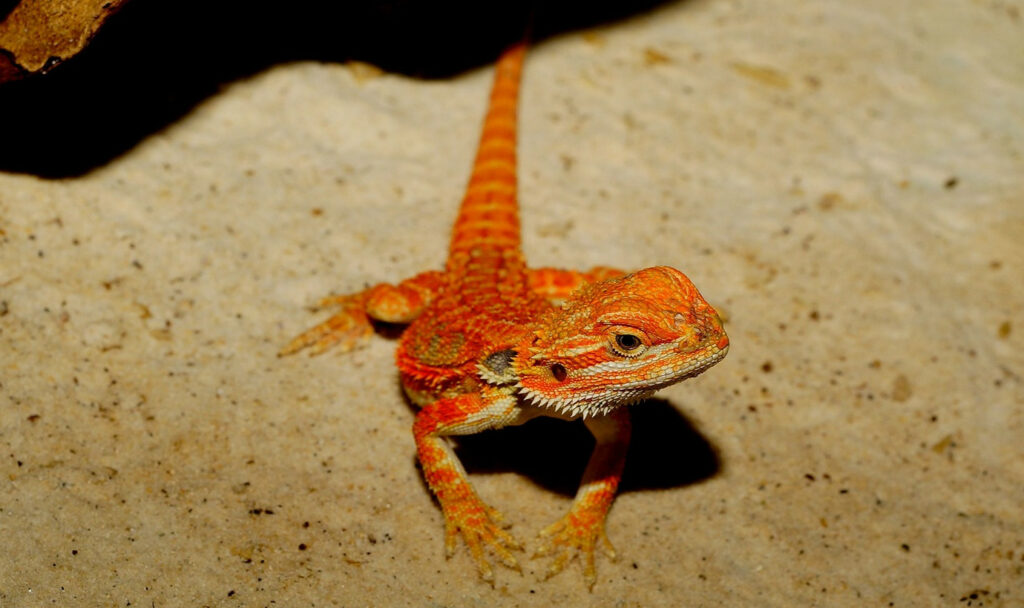
График на хранене
You should feed your baby bearded dragon at least three times a day, preferably in the morning, afternoon, and evening.
You should offer them as many insects as they can eat in one session, and then remove any uneaten insects from the enclosure.
You should also offer them small amounts of fresh dark-leafy greens and vegetables every day, and leave them in a shallow dish for them to graze on throughout the day.
Avoid feeding your baby bearded dragon any fruits, as these are high in sugar and can cause diarrhea and dehydration.
You should also not feed your baby bearded dragon any human foods, such as bread, cheese, meat, or chocolate, as these are unhealthy and can cause digestive problems or poisoning.
How Much to Feed a Baby Bearded Dragon?
The amount of food you should feed your baby bearded dragon depends on its age, size, and activity level.
As a general rule, you should feed your baby bearded dragon as many insects as it can eat in 10 минути, and a small amount of vegetables every day.
You should also provide fresh water daily, and dust the food with calcium and vitamin supplements.
Best Feeder Insects
The best insects to feed your baby bearded dragon are:
Щурци
Crickets are the staple insect for baby bearded dragons, as they are high in protein, low in fat, and easy to digest.
You should choose crickets that are smaller than the space between your baby bearded dragon’s eyes, as larger crickets can cause choking or impaction.
You should also gut-load your crickets, which means feeding them nutritious foods, such as carrots, lettuce, or oatmeal, 24 hours before feeding them to your baby bearded dragon. This will enhance the nutritional value of the crickets and benefit your baby bearded dragon.
You should also dust your crickets with calcium and vitamin D3 powder, which is a supplement that helps your baby bearded dragon absorb calcium and prevent metabolic bone disease.
You should dust your crickets every other day for baby bearded dragons under 6 на месеци, and once or twice a week for baby bearded dragons over 6 на месеци.
Roaches
Roaches are another excellent insect for baby bearded dragons, as they are high in protein, low in fat, and easy to digest.
You should choose roaches that are smaller than the space between your baby bearded dragon’s eyes, as larger roaches can cause choking or impaction. You should also gut-load and dust your roaches as you would with crickets.
The best types of roaches to feed your baby bearded dragon are dubia roaches, discoid roaches, or red runner roaches.
You should avoid feeding your baby bearded dragon any wild roaches, as these can carry parasites or pesticides that could harm your baby bearded dragon.
Worms
Worms are a good treat for baby bearded dragons, as they are high in protein and calcium, but they are also high in fat and phosphorus, което може да попречи на усвояването на калций.
Следователно, you should only feed your baby bearded dragon worms once or twice a week, and in moderation.
You should choose worms that are smaller than the space between your baby bearded dragon’s eyes, as larger worms can cause choking or impaction.
You should also dust your worms with calcium and vitamin D3 powder, as you would with crickets and roaches.
The best types of worms to feed your baby bearded dragon are phoenix worms, копринени буби, or hornworms.
You should avoid feeding your baby bearded dragon any mealworms, суперчервеи, or waxworms, as these are too hard, too large, or too fatty for baby bearded dragons.

How to Bathe a Baby Bearded Dragon
To bathe a baby bearded dragon, you will need a small container, such as a plastic bin or a sink, that is clean and not shared with people or other animals.
Fill the container with lukewarm water that is between 85 и 100 F (29.4 и 37.7 ° С).
The water should be no deeper than the shoulder joints of your dragon to prevent drowning. You can also add a rock or something else for your dragon to climb on if it gets tired.
Avoid using any soap, detergent, or chlorine in the water, тъй като те могат да навредят на кожата или здравето на вашия дракон.
Внимателно поставете своя дракон във водата и го оставете да се аклиматизира. Можете да използвате четка за зъби с мек косъм, за да изчеткате нежно кожата му, особено ако линее. Оставете вашия дракон да се накисва 10 да се 20 минути, но не го оставяйте без надзор.
Ако вашият дракон се изхожда във водата, незабавно отстранете отпадъците. След банята, подсушете вашия дракон с чиста кърпа и го поставете на мястото му за греене, за да се затопли.
Можете да къпете вашето бебе брадат дракон веднъж или два пъти седмично, или по-често, ако линее или е мръсно.
Baby Bearded Dragon FAQs
How to take care of a baby bearded dragon?
Да се грижи за бебе брадат дракон, трябва да им осигурите подходящо и удобно заграждение, което отговаря на тяхното осветление, отопление, влажност, и изисквания за декор.
Също така трябва да ги храните с балансирана и разнообразна диета, която се състои от насекоми и растения, and supplement them with calcium and vitamin D3 powder.
You also need to keep their enclosure clean and sanitary, and monitor their health and behavior regularly.
You also need to handle them gently and carefully, and socialize them with other bearded dragons or humans.
How to tell if a baby bearded dragon is male or female?
The easiest way to tell if a baby bearded dragon is male or female is to look at their vent, which is the opening where they urinate and defecate.
Male bearded dragons have two bulges on either side of the vent, which are the hemipenes, or the male reproductive organs.
Female bearded dragons have only one bulge in the middle of the vent, which is the cloaca, or the female reproductive organ. въпреки това, this method is not very reliable for baby bearded dragons, as their hemipenes or cloaca may not be fully developed or visible until they are 6-12 на месеци.
Another way to tell if a baby bearded dragon is male or female is to look at their head, body, and tail shape.
Male bearded dragons tend to have larger and wider heads, thicker and longer tails, and more muscular and angular bodies.
Female bearded dragons tend to have smaller and narrower heads, thinner and shorter tails, and more slender and rounded bodies.
въпреки това, this method is also not very accurate for baby bearded dragons, as their head, body, and tail shape may not be fully differentiated or noticeable until they are 9-18 на месеци.
Следователно, the best way to tell if a baby bearded dragon is male or female is to wait until they are mature enough, or to consult a veterinarian or a reptile expert.
How many crickets should I feed my baby bearded dragon?
You should feed your baby bearded dragon as many crickets as they can eat in 10-15 минути, at least three times a day.
The size of the crickets should be smaller than the space between your baby bearded dragon’s eyes, to prevent choking or impaction.
You should also gut-load and dust your crickets with calcium and vitamin D3 powder, to enhance their nutritional value and prevent metabolic bone disease.
What can I feed my baby bearded dragon besides crickets?
Crickets are the staple insect for baby bearded dragons, but you can also feed them other insects, such as roaches, червеи, or locusts.
въпреки това, you should avoid feeding them any mealworms, суперчервеи, or waxworms, as these are too hard, too large, or too fatty for baby bearded dragons.
You should also feed your baby bearded dragon fresh greens and vegetables every day, като кейл, зеле, зеленина от глухарче, скуош, моркови, or bell peppers.
You should not feed them any fruits, as these are high in sugar and can cause diarrhea and dehydration.
Why is my baby bearded dragon not eating?
There are many possible reasons why your baby bearded dragon is not eating, като:
- Stress: Your baby bearded dragon may be stressed by a new environment, a new owner, a new enclosure, a new diet, or a new companion. Stress can affect their appetite and digestion, and make them refuse to eat. To reduce stress, you should provide your baby bearded dragon with a secure and comfortable enclosure, a consistent and familiar routine, a gentle and careful handling, and a gradual and smooth introduction to any changes.
- Illness: Your baby bearded dragon may be sick or injured, and may not feel like eating. Illness can be caused by parasites, infections, injuries, or metabolic bone disease. Illness can also cause symptoms such as lethargy, weight loss, dehydration, diarrhea, or abnormal behavior. To prevent illness, you should keep your baby bearded dragon’s enclosure clean and sanitary, feed them a nutritious and varied diet, supplement them with calcium and vitamin D3 powder, and monitor their health and behavior regularly. To treat illness, you should consult a veterinarian or a reptile expert, and follow their advice and medication.
- Линеене: Your baby bearded dragon may be shedding, which is the process of replacing their old skin with a new one. Shedding can occur every few weeks or months, depending on their age and growth rate. Shedding can affect their appetite and digestion, and make them eat less or not at all. To help shedding, you should provide your baby bearded dragon with a humid and warm enclosure, a shallow and lukewarm bath, and a gentle and careful rubbing. You should not pull or peel off their old skin, as this can cause damage or infection.
- Брумация: Your juvenile bearded dragon may be brumating, which is the reptile equivalent of hibernation. Very young bearded dragons (hatchlings less than one year old) do not generally brumate, but there can be exceptions. Brumation can occur during the winter months, when the temperature and light cycle are lower and shorter. Brumation can affect their appetite and digestion, and make them eat less or not at all.
How to Get a Baby Bearded Dragon to Eat?
If your baby bearded dragon is not eating, you should first check its health, температура, and stress level, and consult a vet if needed.
Then, you can try some of these tips to encourage it to eat:
- Offer a varied diet of insects and vegetables, dusted with calcium and vitamin supplements. Feed your baby bearded dragon 3 да се 5 пъти на ден, and remove any uneaten food afterwards.
- Make the food more appealing by mixing, chopping, or blending it, and adding some bee pollen or reptile salad dressing. You can also hide some insects in the salad, or make a slurry and feed it with a syringe.
- Hand feed your baby bearded dragon with tweezers or tongs, and praise and reward it with a treat or a pet. Be patient and gentle, and do not force your baby bearded dragon to eat if it is not interested.
- Hold your ground and do not give in to your baby bearded dragon’s preferences. Offer the same food every day, until your baby bearded dragon eats it. You can also reduce the number of feedings, or skip a day, to make your baby bearded dragon more hungry and willing to eat.
Do baby bearded dragons brumate?
Brumation is a natural process that bearded dragons go through during the colder seasons, when they slow down their metabolism and activity to conserve energy. It is similar to hibernation, but not exactly the same.
Brumation usually occurs in adult bearded dragons, who are at least one year old or more. However, some younger beardies may also show signs of brumation, depending on their environment and instinct.
Baby bearded dragons, who are less than one year old, typically do not brumate. Това е така, защото те все още растат и се развиват, and need regular food and warmth to do so.
Brumation in babies can potentially stunt their growth, affect their size, and cause health complications later on.
Следователно, it is not recommended to let baby bearded dragons brumate, unless they are showing clear signs of wanting to do so.
If your baby bearded dragon is showing signs of brumation, such as sleeping more, eating less, hiding, and being less active, you should first rule out any other possible causes, such as illness, стрес, or improper husbandry.
Bearded Dragon-inspired Gifts & Стока
Като сътрудник на Amazon, може да спечелим комисионна за отговарящи на условията покупки.
БРАДАТ ДРАКОН БЪРЗИ ВРЪЗКИ
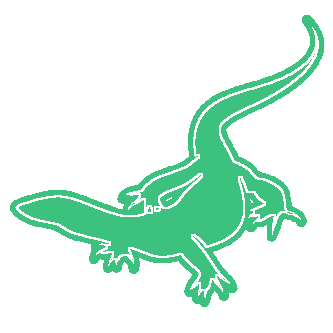
PetsWithScales.com е информационен уебсайт за грижи за домашни любимци на големи гущери. Ние събираме и предоставяме информация от различни източници в мрежата за това как да отглеждаме и да се грижим за влечугите като домашни любимци. Видовете, с които се занимаваме основно са тегу, варан, сцинкове и гекони. Нашата цел е да предоставим висококачествена информация, за да помогнем на собствениците на домашни любимци да се подобрят, по-информирани решения относно диетите на техните животни, здраве и живот.

PetsWithScales.com е информационен уебсайт за грижи за домашни любимци на големи гущери. Ние събираме и предоставяме информация от различни източници в мрежата за това как да отглеждаме и да се грижим за влечугите като домашни любимци. Видовете, с които се занимаваме основно са тегу, варан, сцинкове и гекони. Нашата цел е да предоставим висококачествена информация, за да помогнем на собствениците на домашни любимци да се подобрят, по-информирани решения относно диетите на техните животни, здраве и живот.
